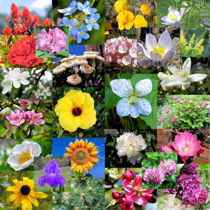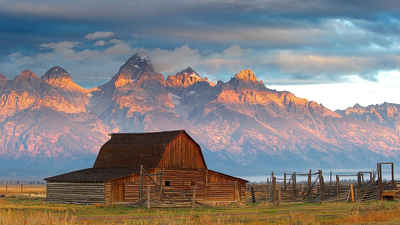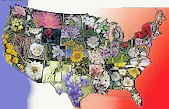Wyoming State Flower
Indian Paintbrush

(Castilleja linariaefolia)
Adopted on January 31, 1917
The Indian paintbrush, (Castilleja linariaefolia,) is a native wildflower in the family Scrophulariaceae (Figwort Family). The Indian Paintbrush or Painted Cup (Castilleja linariaefolia) was adopted as Wyoming State Flower on January 31, 1917.
The Wyoming chapter of the Daughters of the American Revolution supported the Indian paintbrush as Wyoming's state flower. But Dr. Grace R. Hebard gets most of the credit for its adoption. She drafted the state flower bill and found a legislator willing to sponsor it.
Wyoming State Flower: Indian Paintbrush

Castilleja, commonly known as Indian paintbrush or prairie-fire, is a genus of about 200 species of annual and perennial herbaceous plants native to the west of the Americas from Alaska south to the Andes, northern Asia, and one species as far west as the Kola Peninsula in Siberia. These plants are classified in the broomrape family, Orobanchaceae (following major rearrangements of the order Lamiales starting around 2001; sources which do not follow these reclassifications may place them in the Scrophulariaceae). They are hemiparasitic on the roots of grasses and forbs. The generic name honours Spanish botanist Domingo Castillejo.
The roots of the painted cups are partially parasitic on the roots of other green plants. Their true flowers are inconspicuous, but are commonly enveloped by bright red flowerlike bracts. Wyoming's Indian paint brush (Castillija linariaefolia) is also referred to as the desert paintbrush, the Wyoming desert paintbrush, Wyoming paintbrush, the Linaria-leaved Indian Paintbrush, and, as indicated in the Wyoming statute, the Indian paint brush
Characteristics of the Indian Paintbrush
This flower displays various shades of orange, red and sometimes yellow. The Castilleja grows in moist areas, dry areas, and sandy prairies. Its zones range from 3 to 9. The seeds of the Indian Paintbrush usually germinate in the fall and bloom the next spring without pre-treatment. The plant prefers full sun and/or small amounts of shade. The Indian paintbrush has the ability to grow and survive in serpentine soils, which most species are not equipped to handle the stressful amounts of high magnesium, low calcium and overloaded amounts of metals such as chromium and nickel. The height of the Indian paintbrush ranges from 1 to 2 feet tall.
The flowers are edible yet they must be eaten in small quantities. They will absorb selenium, a potentially toxic, alkaline mineral compound in the soil. Where high amounts of selenium in the soil is not present, Indain Paintbrush can be enjoyed in moderation with salads. Various tribes used the flowering parts as a paintbrush. The Chippewa Indians are know the use Indian Paintbrush as a medicine to treat rheumatism and as a bath rinse to make their hair glossy. Both applications are useful due to it's selenium content
The Wyoming Statutes
The law designating the Indian paint brush as the official Wyoming state flower is found in the Wyoming Statutes, Title 8, Chapter 3, Section 8-3-104.
TITLE 8. GENERAL PROVISIONS.
CHAPTER 3. STATE SEAL, FLAG, FLOWER, BIRD AND OTHER SYMBOLS.
SECTION 8-3-104.
8-3-104. State flower.
The Castillija linariaefolia, commonly called "the Indian paint brush," is the state flower of Wyoming.
Taxonomic Hierarchy: Indian Paint Brush
Kingdom: Plantae - Plants
Subkingdom: Tracheobionta - Vascular plants
Superdivision: Spermatophyta - Seed plants
Division: Magnoliophyta - Flowering plants
Class: Magnoliopsida - Dicotyledons
Subclass: Asteridae -
Order: Scrophulariales -
Family; Scrophulariaceae - Figwort family
Genus: Castilleja Mutis ex L. f. - Indian paintbrush
Species:Castilleja Mutis ex L. f. - Indian paintbrush
Castillija linariaefolia
State Floral Emblems








